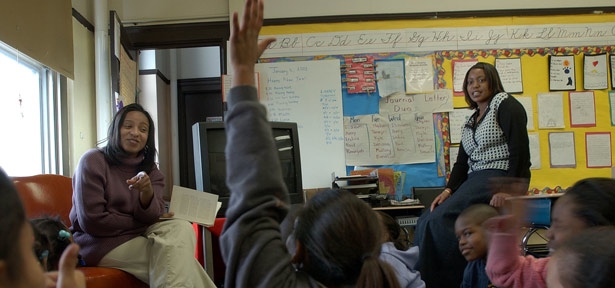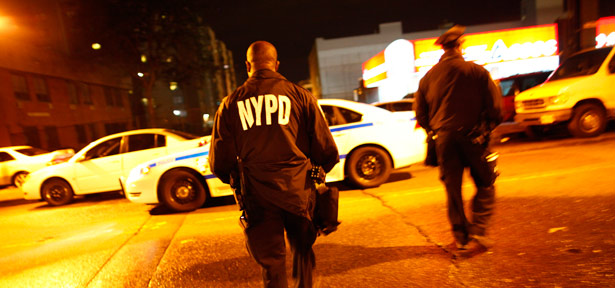Bill de Blasio’s exhilarating landslide victory over Joe Lhota in New York’s mayoral election offers a once-in-a-generation chance for progressives to take the reins of power in America’s largest—and most iconic—city. The rest of the country will be watching as this proud liberal, who earned our enthusiastic endorsement in the primary, moves to deliver on his promise to “leave no New Yorker behind.” The new mayor’s to-do list will be long, and the following is not intended to be comprehensive; but here are five areas where we see immediate possibilities for meaningful change in our city under Mayor de Blasio.
The Economy and Inequality

(AP Photo/Mark Lennihan)
De Blasio’s “tale of two cities” campaign zeroed in on New York City’s most fundamental problem: the dramatic widening of its income gap, a trend that accelerated greatly on Mayor Michael Bloomberg’s watch. As we noted in our May 6 special issue, “The Gilded City,” the richest 1 percent of New Yorkers claimed 39 percent of the city’s income share in 2012—up from 12 percent in 1980. Enacting de Blasio’s campaign proposal to tax earners of $500,000 and up to pay for universal pre-K would be a fine way to begin to reverse this tide, although the state legislature has to be persuaded to get on board, and it may take some time to implement the plan for more mundane reasons, such as the scarcity of classroom space.
Meanwhile, there are other steps the mayor can take to tackle the inequality that he called, in his victory speech, “the defining challenge of our time.” He will have to plug the leaks in the tax system and persuade the state to end tax breaks for luxury properties, close business tax loopholes and cut subsidies for developers (which increased almost tenfold under Bloomberg). And why not push to reinstate the commuter tax? Vast changes in the city’s tax structure aren’t likely—and its mix of personal income and business taxes is already relatively progressive—but halting giveaways to the wealthy is essential if the city is to address its pressing social needs.
The most powerful tool the mayor wields is the city’s $72 billion budget. Rather than nickel-and-dime New Yorkers in the budget process, as they’ve come to expect, the mayor can use it to promote equitable economic development and well-funded services for all. He can make infrastructure investments that save money and energy long term to make the post-Sandy city more resilient in the face of climate change—while increasing the kinds of jobs and industries that offer economic security and upward mobility for ordinary New Yorkers.
Popular
"swipe left below to view more authors"Swipe →Even small changes would make a big difference to many people. For example, the city awards billions of dollars in contracts to nonprofit agencies for social services—for publicly funded childcare, public health, and programs for seniors, youth and the homeless. But as many as 50,000 workers at these agencies are poor or near-poor, according to James Parrott of the Fiscal Policy Institute. The mayor could grant them a living wage as part of the preliminary executive budget for 2015, due January 16.
Labor

(Reuters/Eric Thayer)
A comeback for New York’s working class will require the revival of unions. The labor-friendly mayor will likely honor his promise to restore the job security of the city’s school bus drivers and matrons, who staged an unsuccessful strike this year. The city also owes raises to teachers, nurses and other municipal workers, who have contributed enormously to the city only to see their real earnings decline. But as many of the public sector unions privately recognize, there will have to be some give and take in negotiations as 150 unions working without a contract under Bloomberg seek agreements with the new mayor.
The more critical issue for labor is arguably something else: private sector organizing. De Blasio has pledged to support unionizing efforts by private sector workers, and he attended rallies for fast food and carwash employees during his campaign. Now he can use the moral authority of the office and the powers of the city to facilitate union drives. In this regard, he might look to the model of Mayor Fiorello La Guardia, who used his powers aggressively to help defend the rights of workers in industrial disputes.
To help low-wage workers in other ways, the new mayor can move to expand the paid sick days law to cover the 300,000 workers left out of the measure passed by the City Council this year. And with progressive allies on the council, he can expand the city’s limited living-wage law, which passed last year over Bloomberg’s veto.
Housing and Homelessness

(AP Photo/Jacquelyn Martin)
Mayor Bloomberg’s usual response when reminded that 50,000 homeless people stayed in shelters each night was to criticize their personal choices or to suggest that the shelters had become too attractive. De Blasio has a different attitude, thanks to his understanding of homelessness as an economic problem. He has expressed support for the key reforms urged by advocates for the homeless—for example, directing affordable housing assistance (including Section 8 vouchers and public housing slots) to homeless families.
In terms of affordable housing in general, the mayor-elect has pledged to build 200,000 units in ten years. That’s a laudable goal, but it’s crucial that the new units be truly affordable. Bloomberg’s plan set aside only a third of the units for very low-income tenants—and just 4 percent for the homeless. At a moment when the federal government is doing little for housing, that’s simply not enough. The new mayor can also use his power to appoint members of the Rent Guidelines Board to help ensure that the city remains livable for those who can’t pay the skyrocketing market rents; and he can strengthen inclusionary zoning to ensure that developers either build affordable units or pay into a fund for that purpose (under Bloomberg, this was voluntary).
Education

(AP Photo/Chitose Suzuki)
As de Blasio assumes leadership of New York’s public schools, he will have to figure out how to build on Bloomberg’s accomplishments while addressing the problems that are still festering. There is some dispute about the numbers, but it’s clear that under Bloomberg graduation rates have risen substantially, and several new small schools were created that are better than the big old schools they replaced. Still, there are areas of serious weakness that require a new approach:
1. The education of English-language learners. Under Bloomberg the needs of this growing population were largely ignored, despite their high dropout rates and low academic performance.
2. Support for struggling schools. Bloomberg’s approach was to shut them down instead of providing support networks, especially to those serving the most disadvantaged students.
3. Strategic partnerships in high-poverty neighborhoods. Schools in these areas need social workers, psychologists and health clinics to address the broad array of problems that accompany poverty (approximately 70 percent New York’s public school children come from families near or below the poverty line).
4. A fair evaluation system and a fair compensation package for teachers. If the mayor wants to expand early childhood and after-school programs, he’ll have to get the United Federation of Teachers to support a new contract that leaves resources for these initiatives.
A word on charters: these schools received more attention than any other education issue during the campaign (and a disproportionate amount of support from the outgoing mayor), even though they serve little more than 6 percent of New York’s children. Mayor de Blasio will have to reduce some of the conflict between charter and public schools over issues like co-location so that he can create a more cooperative environment and focus on improving the schools the vast majority of children attend.
Policing and Criminal Justice

(Reuters/Eric Thayer)
First and foremost, the mayor must move to abolish the NYPD’s so-called “productivity goals,” a euphemism for a quota system that under Bloomberg and police chief Ray Kelly has led to indiscriminate ticketing, false arrests, illegal stop-and-frisks, and other harassment techniques that undermine officers’ relationship with communities and result in unfair and counterproductive policing.
Whatever happens with stop-and-frisk in the courts, the mayor must move not merely to curtail but to end this notorious practice, which targets young black and brown men. It’s also critical to put an immediate end to the unwarranted police surveillance of Muslim communities. As the Police Reform Organizing Project notes, however, we also need a wholesale reorientation of policing, away from an aggressive and punitive approach—sometimes called “proactive policing”—and toward community-oriented, problem-solving measures that focus on engaging and collaborating with neighborhood leaders and residents, local service programs, community centers and churches.
Some might say de Blasio has his work cut out for him. But he’ll have a passionate base of supporters, with what looks to be a record number of allies in the City Council’s progressive caucus to back him up and hold him accountable. After twelve years of Bloomberg, it’s extraordinary that liberal New York has gained a sympathetic partner at City Hall. Welcome, Mayor de Blasio.
Read The Nation’s August endoresement of Mayor-elect Bill de Blasio.


